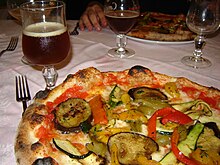
Italy is considered to be part of the wine belt of Europe. Nevertheless, beer, particularly mass-produced pale lagers, are common in the country. It is traditionally considered to be an ideal accompaniment to pizza; since the 1970s, beer has spread from pizzerias and has become much more popular for drinking in other situations.[1]
In the seventh century BC in Sicily, the Phoenicians traded and consumed beer. In Piedmont, Pombia, Province of Novara, an archaeological investigation found tombs from the Golasecca culture, including a tomb from 560 BC containing traces of beer.[2] Ancient Rome knew of beer and produced small amounts, but the systems of production were destroyed in various barbarian invasions.[3] The first medical school, the Schola Medica Salernitana, praised the substance stating that it "supports old age, flows through the veins, increases well-being, and strengthens the blood".[4]
On the occasion of his wedding, Ludovico Sforza distributed beer freely to the Milanese. At this time, it was referred to in Florence as "barley wine".[5] The first brewery in Italy, according to Hermes Zampollo, was "Spluga" in Chiavenna, which opened in 1840. However, the company Wührer stated that its brewing commenced in Brescia in 1829.[1] The first person in Italy to cultivate hops for beer brewing was Gaetano Pasqui in 1847.[6] In 1983, the country consumed 12 million hectolitres (260 million imperial gallons; 320 million US gallons) of beer.[7] As of 2010, Italy has a beer consumption of 30 litres (6.6 imp gal; 7.9 US gal) per capita per year.[8]
